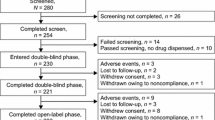Abstract
The extended-release orally disintegrating tablet (XR-ODT) formulation of methylphenidate (Cotempla XR-ODT™) is an effective and generally well-tolerated option for the treatment of attention-deficit hyperactivity disorder (ADHD) in children and adolescents. Because of the pharmacokinetic profile of this formulation, methylphenidate XR-ODT is administered once daily. As methylphenidate XR-ODT comprise both immediate- and extended-release methylphenidate particles, its use may be of particular benefit in individuals who require a rapid onset (clinical improvements are shown within 1 h) and prolonged reduction in ADHD symptoms (clinical improvements are maintained for 12 h). The XR-ODT formulation of methylphenidate allows relatively easy administration (the ODT dissolves rapidly on the tongue, followed by swallowing of the disintegrated particles with saliva without the need for water), which may be of particular benefit in children and adolescents who have difficulty swallowing tablets or capsules.

Similar content being viewed by others
References
Subcommittee on Attention-Deficit/Hyperactivity Disorder; Steering Committee on Quality Improvement and Management, Wolraich M, Brown L, Brown RT, DuPaul G, et al. Clinical practice guideline for the diagnosis, evaluation, and treatment of attention-deficit/ hyperactivity disorder in children and adolescents. Pediatrics. 2011;128(5):1007–22.
Sharma A, Couture J. A review of the pathophysiology, etiology, and treatment of attention-deficit hyperactivity disorder (ADHD). Ann Pharmacother. 2014;48(2):209–25.
Cortese S, D’Acunto G, Konofal E, et al. New formulations of methylphenidate for the treatment of attention-deficit/hyperactivity disorder: pharmacokinetics, efficacy, and tolerability. CNS Drugs. 2017;31(2):149–60.
Mattingly GW, Wilson J, Rostain AL. A clinician’s guide to ADHD treatment options. Postgrad Med. 2017;129(7):657–66.
Cotempla XR-ODT (methylphenidate extended-release orally disintegrating tablets), CII: US prescribing information. Grand Prairie (TX): Neos Therapeutics, Inc.; 2017.
Prince J. Catecholamine dysfunction in attention-deficit/ hyperactivity disorder: an update. J Clin Psychopharmacol. 2008;28(3 Suppl 2):S39–45.
Markowitz JS, Patrick KS. Differential pharmacokinetics and pharmacodynamics of methylphenidate enantiomers: does chirality matter? J Clin Psychopharmacol. 2008;28(3 Suppl 2):S54–61.
Wilens TE. Effects of methylphenidate on the catecholaminergic system in attention-deficit/hyperactivity disorder. J Clin Psychopharmacol. 2008;28(3 Suppl 2):S46–53.
Quinn D. Does chirality matter? Pharmacodynamics of enantiomers of methylphenidate in patients with attentiondeficit/hyperactivity disorder. J Clin Psychopharmacol. 2008;28(3 Suppl 2):S62–6.
Markowitz JS, DeVane CL, Pestreich LK, et al. A comprehensive in vitro screening of d-, l-, and dl-threo-methylphenidate: an exploratory study. J Child Adolesc Psychopharmacol. 2006;16(6):687–98.
Ding YS, Fowler JS, Volkow ND, et al. Chiral drugs: comparison of the pharmacokinetics of [11C]d-threo and l-threo-methylphenidate in the human and baboon brain. Psychopharmacology (Berl). 1997;131(1):71–8.
Childress A, Newcorn J, Stark JG, et al. A single-dose, single-period pharmacokinetic assessment of an extended-release orally disintegrating tablet of methylphenidate in children and adolescents with attention-deficit/hyperactivity disorder. J Child Adolesc Psychopharmacol. 2016;26(6):505–12.
Weisler RH, Stark JG, Sikes C. Fed and fasted administration of a novel extended-release methylphenidate orally disintegrating tablet formulation for the treatment of ADHD. Clin Pharmacol Drug Develop. 2017. https://doi.org/10.1002/cpdd.361.2017 (Epub).
Childress AC, Kollins SH, Cutler AJ, et al. Efficacy, safety, and tolerability of an extended-release orally disintegrating methylphenidate tablet in children 6–12 years of age with attention-deficit/hyperactivity disorder in the laboratory classroom setting. J Child Adolesc Psychopharmacol. 2017;27(1):66–74.
Chavez B, Sopko MA Jr, Ehret MJ, et al. An update on central nervous system stimulant formulations in children and adolescents with attention-deficit/hyperactivity disorder. Ann Pharmacother. 2009;43(6):1084–95.
Bright GM. Abuse of medications employed for the treatment of ADHD: results from a large-scale community survey. Medscape J Med. 2008;10(5):111.
Acknowledgements
The manuscript was reviewed by: A.C. Childress, Center for Psychiatry and Behavioral Medicine, Las Vegas, NV, USA. During the peer review process, the manufacturer of methylphenidate XR-ODT was also offered an opportunity to review this article. Changes resulting from comments received were made on the basis of scientific and editorial merit.
Author information
Authors and Affiliations
Corresponding author
Ethics declarations
Funding
The preparation of this review was not supported by any external funding.
Conflicts of interest
K.A. Lyseng-Williamson is an employee of Adis/Springer, is responsible for the article content and declares no conflicts of interest. Additional information about this Adis Drug Review can be found http://www.medengine.com/Redeem/3DCCF0606350342C.
Rights and permissions
About this article
Cite this article
Lyseng-Williamson, K.A. Methylphenidate extended-release orally disintegrating tablets (Cotempla XR-ODT™) in attention-deficit hyperactivity disorder in children aged 6–17 years: a profile of their use. Drugs Ther Perspect 34, 43–49 (2018). https://doi.org/10.1007/s40267-017-0462-2
Published:
Issue Date:
DOI: https://doi.org/10.1007/s40267-017-0462-2



